MBA501 Kaplan Business School: Facebook Stakeholder Analysis Report
VerifiedAdded on 2022/10/12
|10
|2094
|240
Report
AI Summary
This report provides a comprehensive stakeholder analysis of Facebook, examining the company's vision, mission, recent developments, and challenges within the social media and advertising industry. It identifies key stakeholder groups, including users, government, advertisers, competitors, employees, managers, and owners, and analyzes their roles and responsibilities. The report further focuses on four selected stakeholder groups—advertisers, Facebook users, government, and competitors—assessing their behavior, motives, and potential coalitions. The analysis categorizes these stakeholders based on their influence and strategic importance to Facebook, highlighting the need for the company to effectively manage these relationships to ensure long-term sustainability and revenue generation. The document concludes that understanding and maximizing the potential of these stakeholders is crucial for Facebook's continued success.

Running Head: MANAGEMENT 0
Dynamic Strategy and Disruptive Innovation
Dynamic Strategy and Disruptive Innovation
Paraphrase This Document
Need a fresh take? Get an instant paraphrase of this document with our AI Paraphraser
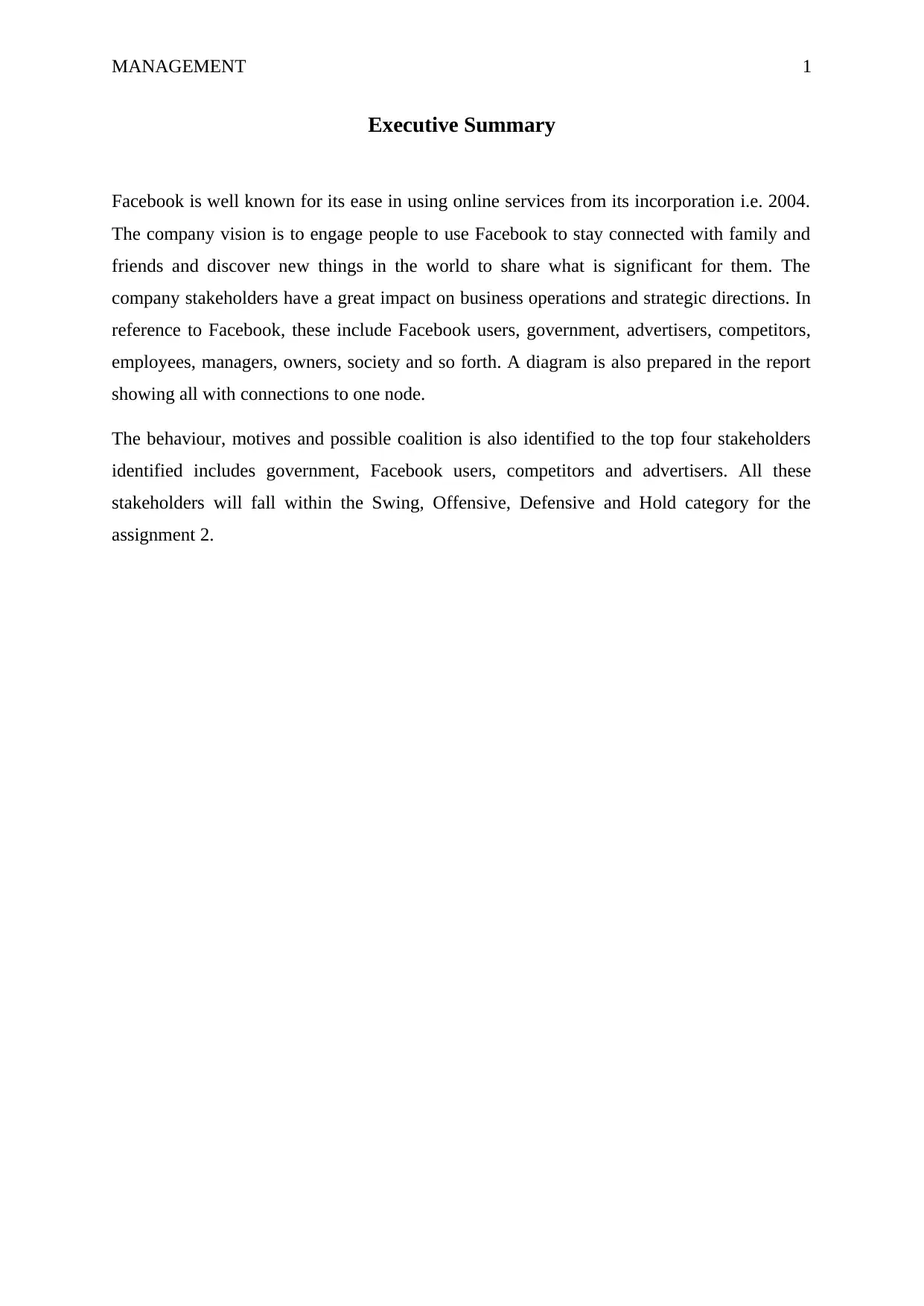
MANAGEMENT 1
Executive Summary
Facebook is well known for its ease in using online services from its incorporation i.e. 2004.
The company vision is to engage people to use Facebook to stay connected with family and
friends and discover new things in the world to share what is significant for them. The
company stakeholders have a great impact on business operations and strategic directions. In
reference to Facebook, these include Facebook users, government, advertisers, competitors,
employees, managers, owners, society and so forth. A diagram is also prepared in the report
showing all with connections to one node.
The behaviour, motives and possible coalition is also identified to the top four stakeholders
identified includes government, Facebook users, competitors and advertisers. All these
stakeholders will fall within the Swing, Offensive, Defensive and Hold category for the
assignment 2.
Executive Summary
Facebook is well known for its ease in using online services from its incorporation i.e. 2004.
The company vision is to engage people to use Facebook to stay connected with family and
friends and discover new things in the world to share what is significant for them. The
company stakeholders have a great impact on business operations and strategic directions. In
reference to Facebook, these include Facebook users, government, advertisers, competitors,
employees, managers, owners, society and so forth. A diagram is also prepared in the report
showing all with connections to one node.
The behaviour, motives and possible coalition is also identified to the top four stakeholders
identified includes government, Facebook users, competitors and advertisers. All these
stakeholders will fall within the Swing, Offensive, Defensive and Hold category for the
assignment 2.

MANAGEMENT 2
Table of Contents
Introduction................................................................................................................................3
Stakeholder View.......................................................................................................................4
Stakeholder Analysis for four selected stakeholder groups.......................................................6
Conclusion..................................................................................................................................8
References..................................................................................................................................9
Table of Contents
Introduction................................................................................................................................3
Stakeholder View.......................................................................................................................4
Stakeholder Analysis for four selected stakeholder groups.......................................................6
Conclusion..................................................................................................................................8
References..................................................................................................................................9
⊘ This is a preview!⊘
Do you want full access?
Subscribe today to unlock all pages.

Trusted by 1+ million students worldwide

MANAGEMENT 3
Introduction
Facebook is an online social networking website that was founded in 2004 by Mark
Zuckerberg. These platforms allow various sorts of users including friends, family, and
professionals to discover the things going in the world through sharing of information and
other means of communication. The company have a global network of users including who
form integration to this platform connected with web applications and virtual interface
(Pempek,Yermolayeva and Calvert, 2009). At present there are 2.38 billion monthly active
users on Facebook and this number is continuously increasing due to the company
diversification and acquisitions.
Facebook also has a one e-commerce website (www.facebook.com) that can be accessed by
both mobile application and web interface allowing users to connect worldwide. Facebook
belongs to social media and advertising industry where the landscape is changing at a fast
pace. Some of the recent trends include deeper and genuine engagement, influencer
marketing, sales enablement, AI and customer service (Ostrom et al, 2010). In addition,
Social media marketing is heading towards a phase that emphasis more on new technologies,
ROI and a trusting relationship between the customers and the brand.
The company vision is to engage people to use Facebook to stay connected with family and
friends, to explore what’s going on in the world and to share and show what is important for
them. On the other hand, the company mission is to give people the power to share and make
the world more connected and open. It was discovered that the company mission and vision
motivates 56% of Facebook employees representing its culture at a Glance (comparably.com,
2019). In extent with recent development, the company has focused towards augmented
reality ads, page recommendations, video metric updates, video creation kit and value
optimisation. On the other hand, one of the biggest challenges to the company is government
trouble (related to data leak) and declining trust in technology.
Introduction
Facebook is an online social networking website that was founded in 2004 by Mark
Zuckerberg. These platforms allow various sorts of users including friends, family, and
professionals to discover the things going in the world through sharing of information and
other means of communication. The company have a global network of users including who
form integration to this platform connected with web applications and virtual interface
(Pempek,Yermolayeva and Calvert, 2009). At present there are 2.38 billion monthly active
users on Facebook and this number is continuously increasing due to the company
diversification and acquisitions.
Facebook also has a one e-commerce website (www.facebook.com) that can be accessed by
both mobile application and web interface allowing users to connect worldwide. Facebook
belongs to social media and advertising industry where the landscape is changing at a fast
pace. Some of the recent trends include deeper and genuine engagement, influencer
marketing, sales enablement, AI and customer service (Ostrom et al, 2010). In addition,
Social media marketing is heading towards a phase that emphasis more on new technologies,
ROI and a trusting relationship between the customers and the brand.
The company vision is to engage people to use Facebook to stay connected with family and
friends, to explore what’s going on in the world and to share and show what is important for
them. On the other hand, the company mission is to give people the power to share and make
the world more connected and open. It was discovered that the company mission and vision
motivates 56% of Facebook employees representing its culture at a Glance (comparably.com,
2019). In extent with recent development, the company has focused towards augmented
reality ads, page recommendations, video metric updates, video creation kit and value
optimisation. On the other hand, one of the biggest challenges to the company is government
trouble (related to data leak) and declining trust in technology.
Paraphrase This Document
Need a fresh take? Get an instant paraphrase of this document with our AI Paraphraser
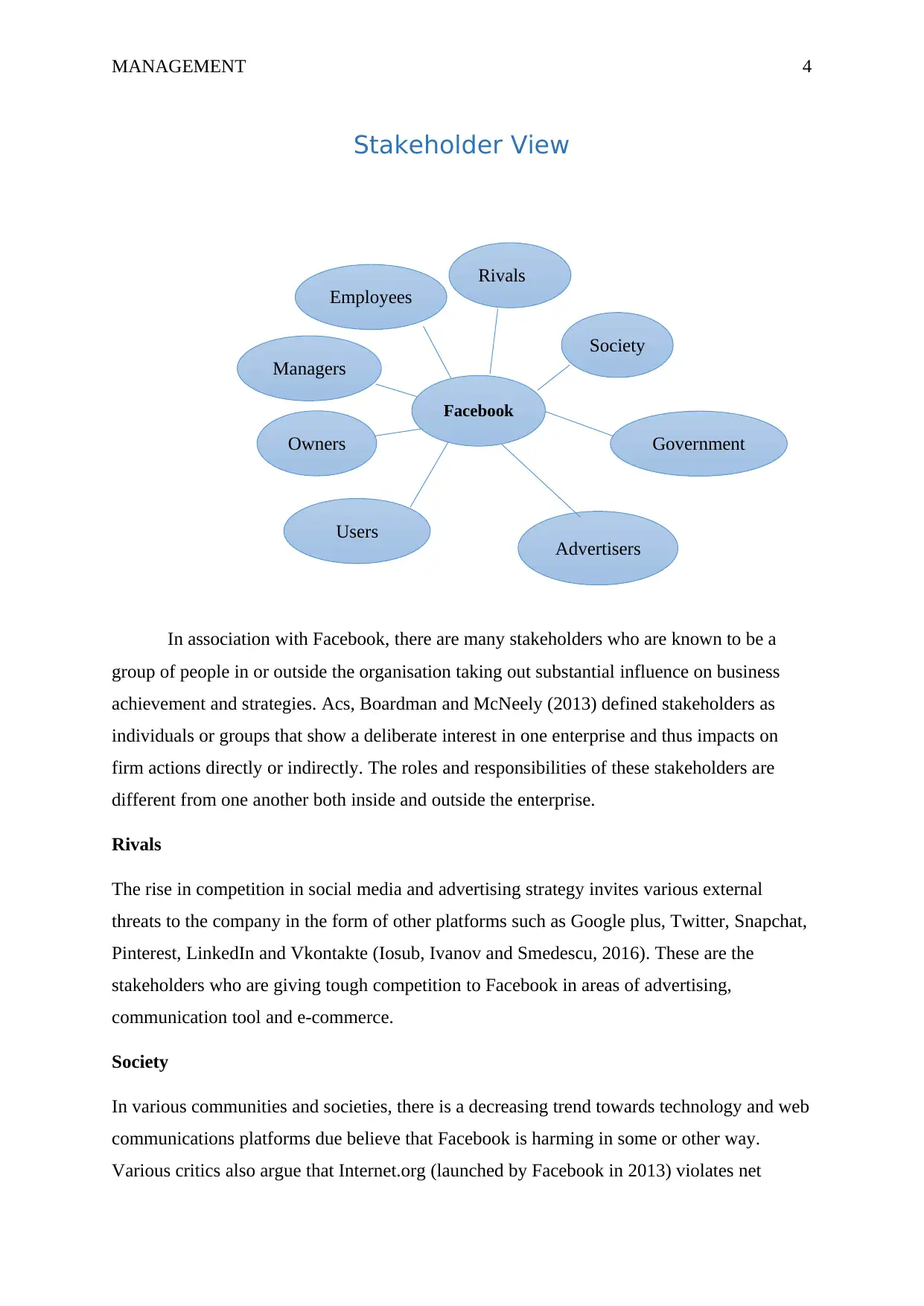
MANAGEMENT 4
Stakeholder View
In association with Facebook, there are many stakeholders who are known to be a
group of people in or outside the organisation taking out substantial influence on business
achievement and strategies. Acs, Boardman and McNeely (2013) defined stakeholders as
individuals or groups that show a deliberate interest in one enterprise and thus impacts on
firm actions directly or indirectly. The roles and responsibilities of these stakeholders are
different from one another both inside and outside the enterprise.
Rivals
The rise in competition in social media and advertising strategy invites various external
threats to the company in the form of other platforms such as Google plus, Twitter, Snapchat,
Pinterest, LinkedIn and Vkontakte (Iosub, Ivanov and Smedescu, 2016). These are the
stakeholders who are giving tough competition to Facebook in areas of advertising,
communication tool and e-commerce.
Society
In various communities and societies, there is a decreasing trend towards technology and web
communications platforms due believe that Facebook is harming in some or other way.
Various critics also argue that Internet.org (launched by Facebook in 2013) violates net
Managers
GovernmentOwners
Employees
Users Advertisers
Society
Rivals
Facebook
Stakeholder View
In association with Facebook, there are many stakeholders who are known to be a
group of people in or outside the organisation taking out substantial influence on business
achievement and strategies. Acs, Boardman and McNeely (2013) defined stakeholders as
individuals or groups that show a deliberate interest in one enterprise and thus impacts on
firm actions directly or indirectly. The roles and responsibilities of these stakeholders are
different from one another both inside and outside the enterprise.
Rivals
The rise in competition in social media and advertising strategy invites various external
threats to the company in the form of other platforms such as Google plus, Twitter, Snapchat,
Pinterest, LinkedIn and Vkontakte (Iosub, Ivanov and Smedescu, 2016). These are the
stakeholders who are giving tough competition to Facebook in areas of advertising,
communication tool and e-commerce.
Society
In various communities and societies, there is a decreasing trend towards technology and web
communications platforms due believe that Facebook is harming in some or other way.
Various critics also argue that Internet.org (launched by Facebook in 2013) violates net
Managers
GovernmentOwners
Employees
Users Advertisers
Society
Rivals
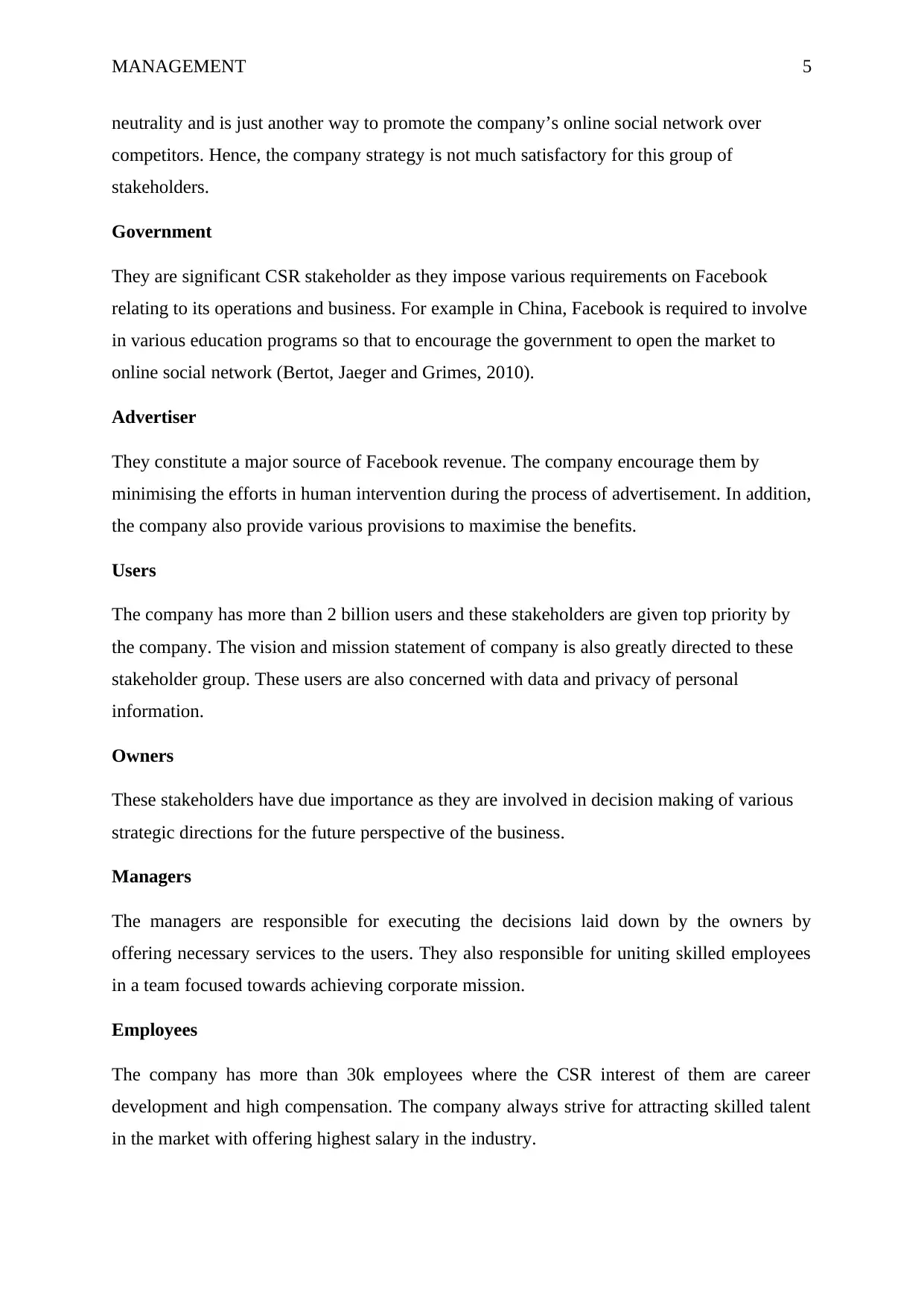
MANAGEMENT 5
neutrality and is just another way to promote the company’s online social network over
competitors. Hence, the company strategy is not much satisfactory for this group of
stakeholders.
Government
They are significant CSR stakeholder as they impose various requirements on Facebook
relating to its operations and business. For example in China, Facebook is required to involve
in various education programs so that to encourage the government to open the market to
online social network (Bertot, Jaeger and Grimes, 2010).
Advertiser
They constitute a major source of Facebook revenue. The company encourage them by
minimising the efforts in human intervention during the process of advertisement. In addition,
the company also provide various provisions to maximise the benefits.
Users
The company has more than 2 billion users and these stakeholders are given top priority by
the company. The vision and mission statement of company is also greatly directed to these
stakeholder group. These users are also concerned with data and privacy of personal
information.
Owners
These stakeholders have due importance as they are involved in decision making of various
strategic directions for the future perspective of the business.
Managers
The managers are responsible for executing the decisions laid down by the owners by
offering necessary services to the users. They also responsible for uniting skilled employees
in a team focused towards achieving corporate mission.
Employees
The company has more than 30k employees where the CSR interest of them are career
development and high compensation. The company always strive for attracting skilled talent
in the market with offering highest salary in the industry.
neutrality and is just another way to promote the company’s online social network over
competitors. Hence, the company strategy is not much satisfactory for this group of
stakeholders.
Government
They are significant CSR stakeholder as they impose various requirements on Facebook
relating to its operations and business. For example in China, Facebook is required to involve
in various education programs so that to encourage the government to open the market to
online social network (Bertot, Jaeger and Grimes, 2010).
Advertiser
They constitute a major source of Facebook revenue. The company encourage them by
minimising the efforts in human intervention during the process of advertisement. In addition,
the company also provide various provisions to maximise the benefits.
Users
The company has more than 2 billion users and these stakeholders are given top priority by
the company. The vision and mission statement of company is also greatly directed to these
stakeholder group. These users are also concerned with data and privacy of personal
information.
Owners
These stakeholders have due importance as they are involved in decision making of various
strategic directions for the future perspective of the business.
Managers
The managers are responsible for executing the decisions laid down by the owners by
offering necessary services to the users. They also responsible for uniting skilled employees
in a team focused towards achieving corporate mission.
Employees
The company has more than 30k employees where the CSR interest of them are career
development and high compensation. The company always strive for attracting skilled talent
in the market with offering highest salary in the industry.
⊘ This is a preview!⊘
Do you want full access?
Subscribe today to unlock all pages.

Trusted by 1+ million students worldwide
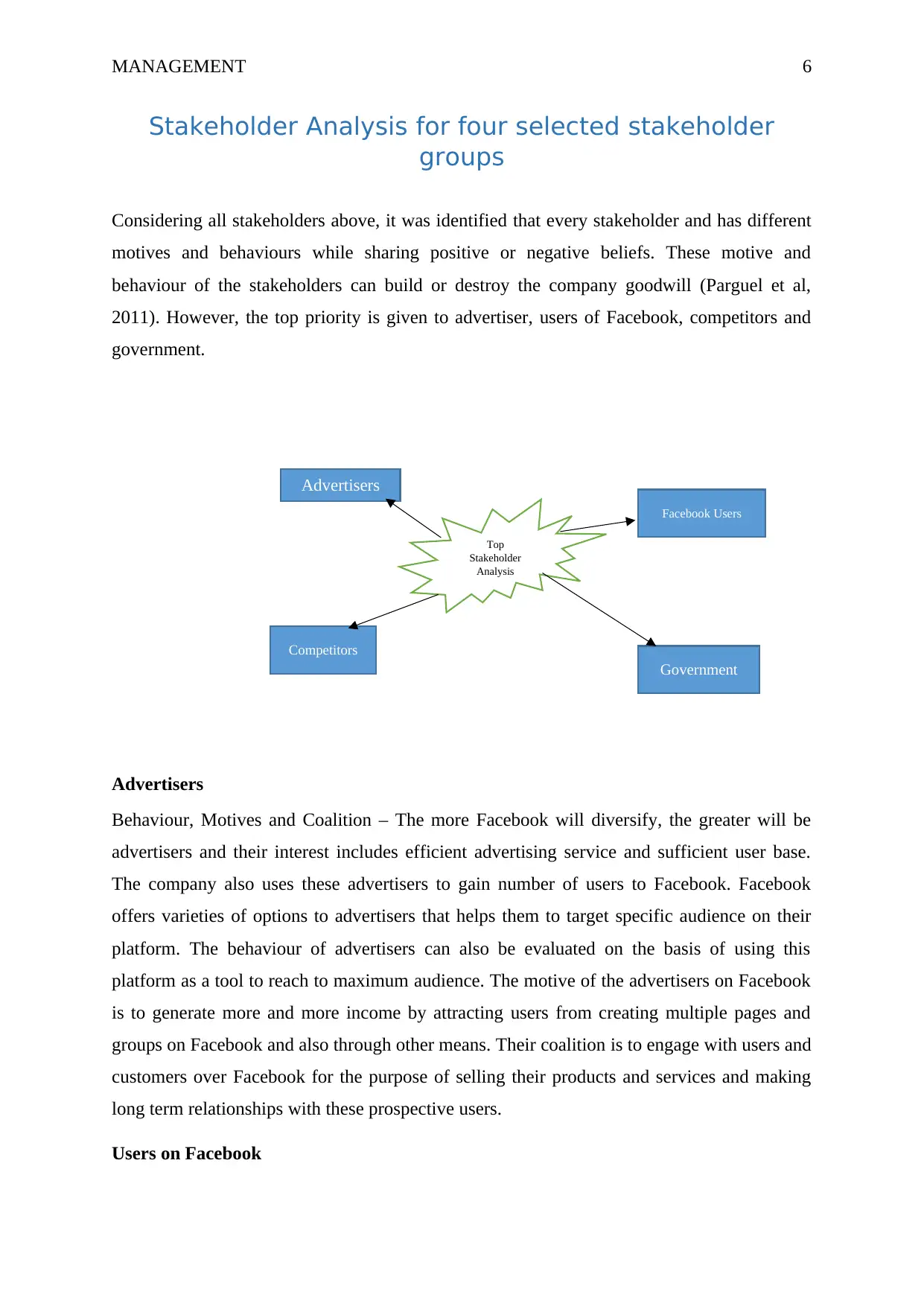
MANAGEMENT 6
Stakeholder Analysis for four selected stakeholder
groups
Considering all stakeholders above, it was identified that every stakeholder and has different
motives and behaviours while sharing positive or negative beliefs. These motive and
behaviour of the stakeholders can build or destroy the company goodwill (Parguel et al,
2011). However, the top priority is given to advertiser, users of Facebook, competitors and
government.
Advertisers
Behaviour, Motives and Coalition – The more Facebook will diversify, the greater will be
advertisers and their interest includes efficient advertising service and sufficient user base.
The company also uses these advertisers to gain number of users to Facebook. Facebook
offers varieties of options to advertisers that helps them to target specific audience on their
platform. The behaviour of advertisers can also be evaluated on the basis of using this
platform as a tool to reach to maximum audience. The motive of the advertisers on Facebook
is to generate more and more income by attracting users from creating multiple pages and
groups on Facebook and also through other means. Their coalition is to engage with users and
customers over Facebook for the purpose of selling their products and services and making
long term relationships with these prospective users.
Users on Facebook
Top
Stakeholder
Analysis
Advertisers
Facebook Users
Competitors
Government
Stakeholder Analysis for four selected stakeholder
groups
Considering all stakeholders above, it was identified that every stakeholder and has different
motives and behaviours while sharing positive or negative beliefs. These motive and
behaviour of the stakeholders can build or destroy the company goodwill (Parguel et al,
2011). However, the top priority is given to advertiser, users of Facebook, competitors and
government.
Advertisers
Behaviour, Motives and Coalition – The more Facebook will diversify, the greater will be
advertisers and their interest includes efficient advertising service and sufficient user base.
The company also uses these advertisers to gain number of users to Facebook. Facebook
offers varieties of options to advertisers that helps them to target specific audience on their
platform. The behaviour of advertisers can also be evaluated on the basis of using this
platform as a tool to reach to maximum audience. The motive of the advertisers on Facebook
is to generate more and more income by attracting users from creating multiple pages and
groups on Facebook and also through other means. Their coalition is to engage with users and
customers over Facebook for the purpose of selling their products and services and making
long term relationships with these prospective users.
Users on Facebook
Top
Stakeholder
Analysis
Advertisers
Facebook Users
Competitors
Government
Paraphrase This Document
Need a fresh take? Get an instant paraphrase of this document with our AI Paraphraser
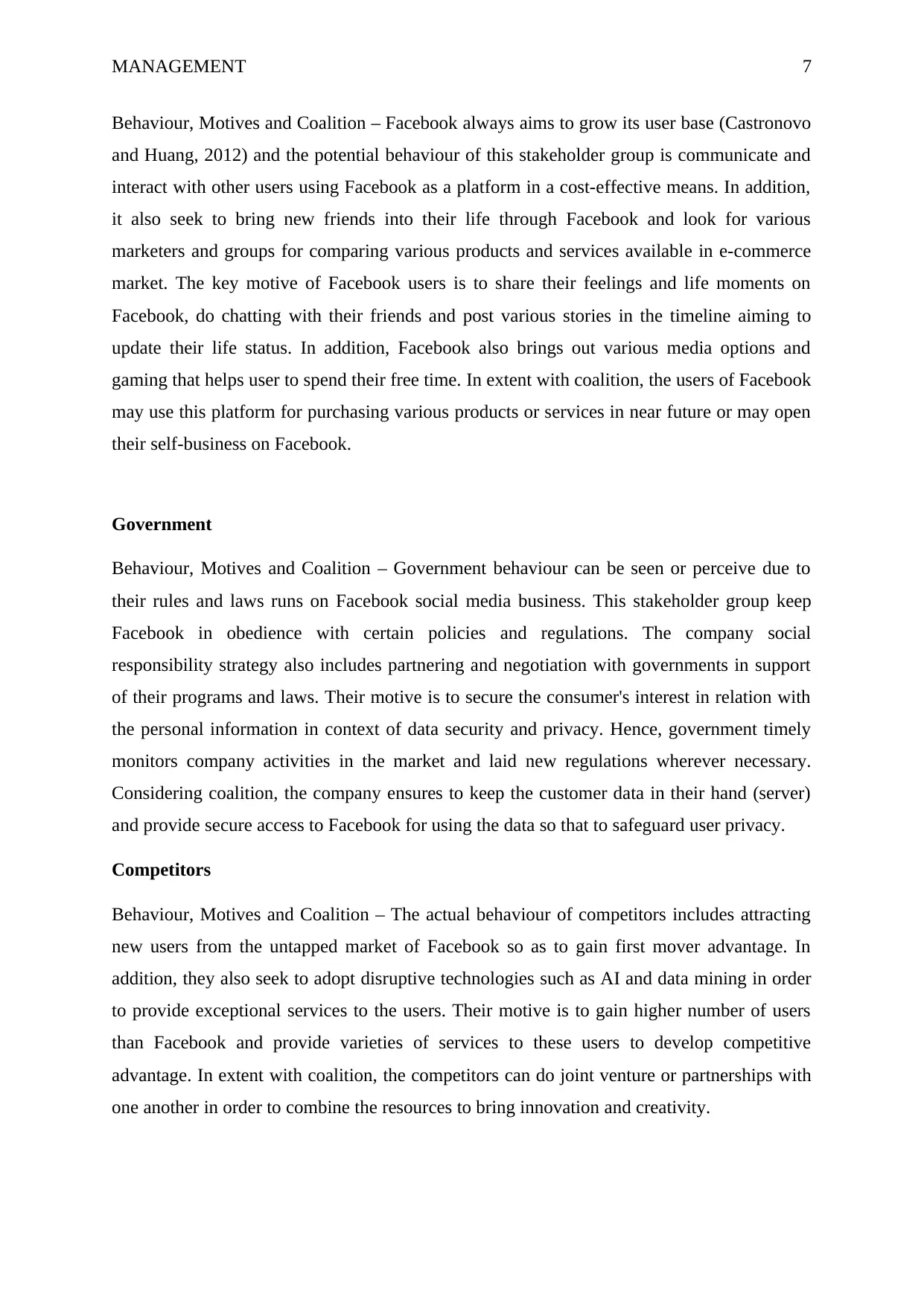
MANAGEMENT 7
Behaviour, Motives and Coalition – Facebook always aims to grow its user base (Castronovo
and Huang, 2012) and the potential behaviour of this stakeholder group is communicate and
interact with other users using Facebook as a platform in a cost-effective means. In addition,
it also seek to bring new friends into their life through Facebook and look for various
marketers and groups for comparing various products and services available in e-commerce
market. The key motive of Facebook users is to share their feelings and life moments on
Facebook, do chatting with their friends and post various stories in the timeline aiming to
update their life status. In addition, Facebook also brings out various media options and
gaming that helps user to spend their free time. In extent with coalition, the users of Facebook
may use this platform for purchasing various products or services in near future or may open
their self-business on Facebook.
Government
Behaviour, Motives and Coalition – Government behaviour can be seen or perceive due to
their rules and laws runs on Facebook social media business. This stakeholder group keep
Facebook in obedience with certain policies and regulations. The company social
responsibility strategy also includes partnering and negotiation with governments in support
of their programs and laws. Their motive is to secure the consumer's interest in relation with
the personal information in context of data security and privacy. Hence, government timely
monitors company activities in the market and laid new regulations wherever necessary.
Considering coalition, the company ensures to keep the customer data in their hand (server)
and provide secure access to Facebook for using the data so that to safeguard user privacy.
Competitors
Behaviour, Motives and Coalition – The actual behaviour of competitors includes attracting
new users from the untapped market of Facebook so as to gain first mover advantage. In
addition, they also seek to adopt disruptive technologies such as AI and data mining in order
to provide exceptional services to the users. Their motive is to gain higher number of users
than Facebook and provide varieties of services to these users to develop competitive
advantage. In extent with coalition, the competitors can do joint venture or partnerships with
one another in order to combine the resources to bring innovation and creativity.
Behaviour, Motives and Coalition – Facebook always aims to grow its user base (Castronovo
and Huang, 2012) and the potential behaviour of this stakeholder group is communicate and
interact with other users using Facebook as a platform in a cost-effective means. In addition,
it also seek to bring new friends into their life through Facebook and look for various
marketers and groups for comparing various products and services available in e-commerce
market. The key motive of Facebook users is to share their feelings and life moments on
Facebook, do chatting with their friends and post various stories in the timeline aiming to
update their life status. In addition, Facebook also brings out various media options and
gaming that helps user to spend their free time. In extent with coalition, the users of Facebook
may use this platform for purchasing various products or services in near future or may open
their self-business on Facebook.
Government
Behaviour, Motives and Coalition – Government behaviour can be seen or perceive due to
their rules and laws runs on Facebook social media business. This stakeholder group keep
Facebook in obedience with certain policies and regulations. The company social
responsibility strategy also includes partnering and negotiation with governments in support
of their programs and laws. Their motive is to secure the consumer's interest in relation with
the personal information in context of data security and privacy. Hence, government timely
monitors company activities in the market and laid new regulations wherever necessary.
Considering coalition, the company ensures to keep the customer data in their hand (server)
and provide secure access to Facebook for using the data so that to safeguard user privacy.
Competitors
Behaviour, Motives and Coalition – The actual behaviour of competitors includes attracting
new users from the untapped market of Facebook so as to gain first mover advantage. In
addition, they also seek to adopt disruptive technologies such as AI and data mining in order
to provide exceptional services to the users. Their motive is to gain higher number of users
than Facebook and provide varieties of services to these users to develop competitive
advantage. In extent with coalition, the competitors can do joint venture or partnerships with
one another in order to combine the resources to bring innovation and creativity.

MANAGEMENT 8
Conclusion
In the limelight of above discussion, it can be said that users, government, competitors and
advertisers play a key role in the success of Facebook achievement and success. These groups
of stakeholder are inter-related to each other and have their own behaviour. It is important for
Facebook to maximise the potential of these stakeholders to generate more revenue over a
longer period of time and ensures its sustainability.
Conclusion
In the limelight of above discussion, it can be said that users, government, competitors and
advertisers play a key role in the success of Facebook achievement and success. These groups
of stakeholder are inter-related to each other and have their own behaviour. It is important for
Facebook to maximise the potential of these stakeholders to generate more revenue over a
longer period of time and ensures its sustainability.
⊘ This is a preview!⊘
Do you want full access?
Subscribe today to unlock all pages.

Trusted by 1+ million students worldwide
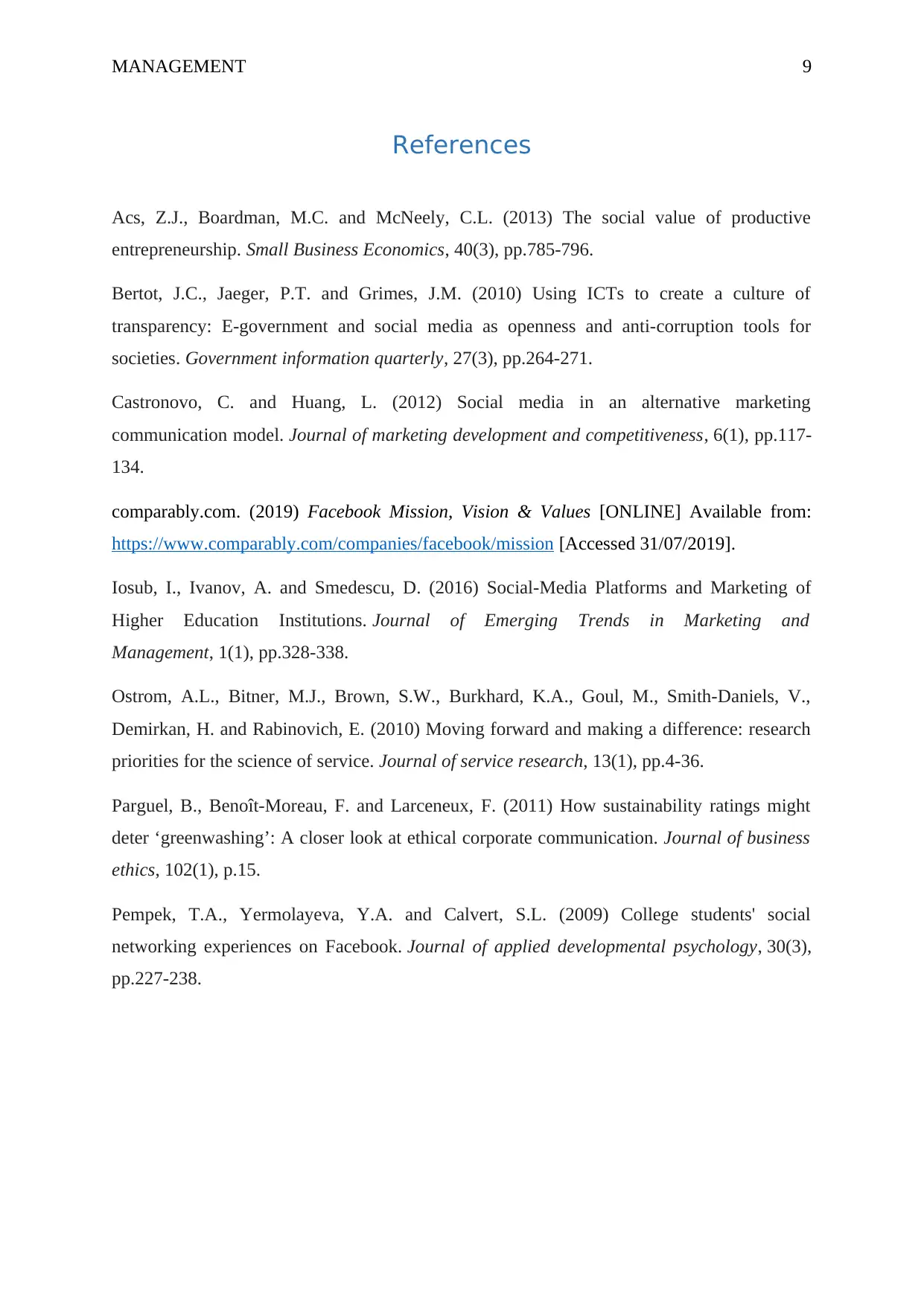
MANAGEMENT 9
References
Acs, Z.J., Boardman, M.C. and McNeely, C.L. (2013) The social value of productive
entrepreneurship. Small Business Economics, 40(3), pp.785-796.
Bertot, J.C., Jaeger, P.T. and Grimes, J.M. (2010) Using ICTs to create a culture of
transparency: E-government and social media as openness and anti-corruption tools for
societies. Government information quarterly, 27(3), pp.264-271.
Castronovo, C. and Huang, L. (2012) Social media in an alternative marketing
communication model. Journal of marketing development and competitiveness, 6(1), pp.117-
134.
comparably.com. (2019) Facebook Mission, Vision & Values [ONLINE] Available from:
https://www.comparably.com/companies/facebook/mission [Accessed 31/07/2019].
Iosub, I., Ivanov, A. and Smedescu, D. (2016) Social-Media Platforms and Marketing of
Higher Education Institutions. Journal of Emerging Trends in Marketing and
Management, 1(1), pp.328-338.
Ostrom, A.L., Bitner, M.J., Brown, S.W., Burkhard, K.A., Goul, M., Smith-Daniels, V.,
Demirkan, H. and Rabinovich, E. (2010) Moving forward and making a difference: research
priorities for the science of service. Journal of service research, 13(1), pp.4-36.
Parguel, B., Benoît-Moreau, F. and Larceneux, F. (2011) How sustainability ratings might
deter ‘greenwashing’: A closer look at ethical corporate communication. Journal of business
ethics, 102(1), p.15.
Pempek, T.A., Yermolayeva, Y.A. and Calvert, S.L. (2009) College students' social
networking experiences on Facebook. Journal of applied developmental psychology, 30(3),
pp.227-238.
References
Acs, Z.J., Boardman, M.C. and McNeely, C.L. (2013) The social value of productive
entrepreneurship. Small Business Economics, 40(3), pp.785-796.
Bertot, J.C., Jaeger, P.T. and Grimes, J.M. (2010) Using ICTs to create a culture of
transparency: E-government and social media as openness and anti-corruption tools for
societies. Government information quarterly, 27(3), pp.264-271.
Castronovo, C. and Huang, L. (2012) Social media in an alternative marketing
communication model. Journal of marketing development and competitiveness, 6(1), pp.117-
134.
comparably.com. (2019) Facebook Mission, Vision & Values [ONLINE] Available from:
https://www.comparably.com/companies/facebook/mission [Accessed 31/07/2019].
Iosub, I., Ivanov, A. and Smedescu, D. (2016) Social-Media Platforms and Marketing of
Higher Education Institutions. Journal of Emerging Trends in Marketing and
Management, 1(1), pp.328-338.
Ostrom, A.L., Bitner, M.J., Brown, S.W., Burkhard, K.A., Goul, M., Smith-Daniels, V.,
Demirkan, H. and Rabinovich, E. (2010) Moving forward and making a difference: research
priorities for the science of service. Journal of service research, 13(1), pp.4-36.
Parguel, B., Benoît-Moreau, F. and Larceneux, F. (2011) How sustainability ratings might
deter ‘greenwashing’: A closer look at ethical corporate communication. Journal of business
ethics, 102(1), p.15.
Pempek, T.A., Yermolayeva, Y.A. and Calvert, S.L. (2009) College students' social
networking experiences on Facebook. Journal of applied developmental psychology, 30(3),
pp.227-238.
1 out of 10
Related Documents
Your All-in-One AI-Powered Toolkit for Academic Success.
+13062052269
info@desklib.com
Available 24*7 on WhatsApp / Email
![[object Object]](/_next/static/media/star-bottom.7253800d.svg)
Unlock your academic potential
Copyright © 2020–2025 A2Z Services. All Rights Reserved. Developed and managed by ZUCOL.





